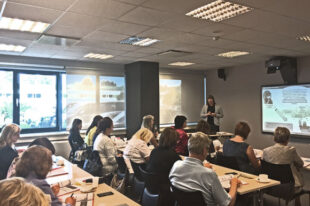Implementation of Deliberations: Case Study of Audit at the Transport Infrastructure Agency

Authors: Walisson Alan Correia de Almeida and Luiz Fernando Ururahy de Souza, Federal External Control Auditors, Tribunal de Contas da União
1 – Introduction
The Supreme Audit Institution (SAI) of Brazil, known as the Tribunal de Contas da União (TCU), is tasked with overseeing the federal entity’s accounting, financial, budgetary, operational, and asset management to ensure legality, legitimacy, and economy. The Federal Constitution of 1988 empowers the TCU to enforce compliance with the law by setting deadlines for necessary corrective measures upon detecting illegality.
The TCU has the authority to issue two types of deliberations: determinations and recommendations. Determinations are mandatory, requiring the recipient to take specific, immediate actions to prevent or correct irregularities, remove their effects, or avoid executing irregular acts within a stipulated timeframe. Recommendations, on the other hand, are collaborative, offering the recipient opportunities for improvement to enhance management practices or public policies and government programs.
Monitoring serves as a crucial tool for the TCU to verify the execution and effectiveness of its determinations and recommendations. Unlike follow-up, which entails continuous oversight of public policies and government programs, monitoring specifically assesses the adherence to and impact of TCU deliberations.
This study presents a case analysis aimed at evaluating the influence of a TCU determination, issued following an audit of a government agency, on the efficient use of public resources. It explores how the TCU’s monitoring process impacted the agency’s performance and seeks to identify successful strategies and areas needing enhancement. The goal is to derive lessons learned and practical insights that could benefit other SAIs in their oversight functions, thereby contributing to the broader discourse on public sector accountability and resource management.
2 – Case study context
The agency that manages Brazil’s transportation infrastructure policy is known as the Departamento Nacional de Infraestrutura de Transportes (DNIT). An audit, process 013.068/2016-4, was conducted to check the execution of maintenance works on road sections under the National Road Safety and Signaling Program (BR-Legal Program), aiming to boost the safety of federal highways under DNIT’s jurisdiction.
This audit was a continuation of previous ones targeting road safety in high-accident areas, which identified several irregularities such as non-compliance with technical standards (lane width, superelevation, shoulder existence), signaling and safety element inadequacies, and issues with maintenance and cleanliness.
Additionally, delays in delivering executive projects were noted, further delaying road safety improvements. In response, the TCU carried out a new audit to reassess the road safety policy and rectify identified shortcomings.
3 – Development of the determination during the audit
The main problem addressed in the audit was the inclusion of road sections managed by state agencies and segments granted to the private sector in the bidding notice of the BR-Legal Program. Additionally, the audit reviewed the scope of covered unpaved or even unimplemented road sections.
Thus, competitors submitted proposals encompassing services throughout the extension of the highways mentioned in the notice. However, the winners were partially executing the contracts, without proportional value reduction. During the audit, it was verified that such occurrences were present in several sections of the program.
At the time, the prevailing methodology used by the TCU to develop determinations and recommendations was established in Resolution 265/2014.
This norm already tried to ensure that the determinations were clear, actionable, and relevant to the agencies. The determinations should be issued with defined deadlines for implementation and communication to the TCU of the measures adopted. Or, in more complex cases, for the presentation of an action plan aimed at solving the problem, requiring the specification of the actions to be adopted, responsible parties, and deadlines for implementation.
It also stipulated that the determinations should prioritize aspects relevant to correcting the main deficiencies identified in the audit, and be based on facts pointed out or analyses carried out. Determinations highlight “what” needed improvement or correction without prescribing “how” to perform such a task and be preceded by an assessment of the feasibility of its implementation.
Thus, Decision 2.828/2016-Plenary determined that DNIT reassess all contracts within the scope of the BR-Legal Program to identify and, if necessary, remove, values referring to services on federal highways not implemented, under construction, or outside its jurisdiction. The granted deadline was 60 days.
This determination aligned with the objectives and needs of DNIT and the BR-Legal Program, as it aimed at efficiency in the use of public resources, with investment in services that are effectively feasible and under the agency’s jurisdiction.
It is also observed that the determination focuses on the reevaluation of contracts with services not applicable due to the situation of the highways, is based on facts pointed out or analyses carried out in the deliberation report, and leaves the way to make corrections at the discretion of the agency.
However, it is noted that it was not adequately preceded by an assessment of the feasibility of its implementation, as indicated by the meager 60-day deadline granted. This suggests that there was no consideration of the agency’s operational capacities and the practical challenges that could arise during the reevaluation process, as will be demonstrated below.
4 – Monitoring and implementation of the determination
Administrative Order 27/2009 outlines the monitoring of determinations and recommendations, encompassing planning, execution, report drafting, and quality assurance. The TCU’s main method for interacting with agencies during this monitoring phase is through diligence, a process used to request necessary information or documents for reviewing cases. This includes setting deadlines for the submission of such information or documents, crucial for clarifying uncertainties, gathering evidence, and checking the execution of decisions. It’s aimed at accurately determining facts to provide a solid foundation for TCU’s rulings.
In the monitored case, the primary issue identified was the insufficient assessment of the feasibility of implementing the determinations. This oversight failed to consider the agency’s operational capabilities and the potential practical challenges that might emerge during the reevaluation of contracts.
The original determination was given a 60-day deadline for implementation. However, it was only deemed completed in 2019, nearly three years after the initial decision. The implementation faced several hurdles: a shortage of qualified staff and team overloads; excessive bureaucracy, characterized by intricate administrative procedures and the necessity for numerous approvals; and changes in management, which disrupted the continuity of information, shifted priorities, and led to confusion regarding the initial determinations.
To overcome these obstacles, the deadline was extended, and multiple diligences were issued. This indicates a need for the TCU to reevaluate its procedures and strengthen communication and coordination with agencies from the point of issuing to monitoring determinations, ensuring more effective and timely implementation.
5 – Impact on the audited program
Despite obstacles and delays, the TCU’s deliberation notably benefited the BR-Legal Program, as highlighted in Decision 2.232/2019-Plenary. This intervention led to marked improvements in program management and execution, enhancing efficiency.
Significant cost savings were realized by adjusting 57 of the 109 contracts, saving around R$ 458 million (about U$ 90 million at the May/2024 rate). This achievement underscores better resource allocation, aligning expenditures with the program’s actual needs.
Additionally, the effort uncovered potential for executing irregular services, spotlighting program flaws. The TCU’s corrective actions, which included adjusting contractual values, demonstrated a dedication to transparency and responsible management, reducing treasury risks. This approach not only corrected immediate issues but also set a precedent for managing public funds more effectively, ensuring accountability and minimizing potential financial losses.
6 – Participatory construction of deliberations
To enhance the effectiveness of control actions and deliberation quality, the TCU revised its methodology with Resolution 315/2020. This adjustment emphasizes involving auditees in the deliberation process by sharing preliminary audit reports containing determination or recommendation drafts and seeking their feedback on the implementation’s practical impacts and alternatives within a reasonable period.
The resolution mandates incorporating auditees’ responses into the final deliberation drafts. If auditees identify adverse impacts or suggest more efficient solutions, the TCU must justify maintaining the initial proposals. This process ensures an inclusive approach, considering auditees’ inputs in the TCU’s deliberations, aiming for more informed and effective decision-making that accounts for the practicalities and potential improvements suggested by those being audited.
7 – Lessons learned and best practices
The case study underscores the importance of properly assessing the feasibility of implementing deliberations. Overlooking an agency’s operational capabilities can lead to unrealistic deadlines and significant delays. It’s crucial for SAIs to analyze an audited agency’s capacity to implement recommendations within set deadlines, considering potential challenges.
To mitigate this issue, the TCU refined its communication with audited agencies, fostering constructive dialogue and enabling the submission of comments and alternatives during the audit process. Emphasizing transparency and decision justification is key to building trust and collaboration between entities. Other SAIs could adopt this approach, engaging audited agencies in the deliberation process and encouraging ongoing dialogue to enhance audit efficiency.
Despite encountered challenges, the audit and monitoring’s positive impact on the audited program was notable, leading to marked improvements in program management and execution. Contract reevaluation and renegotiation resulted in significant cost savings, demonstrating the effectiveness of SAI audits and monitoring in promoting allocative efficiency and ensuring proper public resource utilization.






